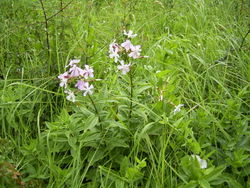Saponaria officinalis
| Soapwort | |
|---|---|
 | |
| Binomial: | Saponaria officinalis |
| Family: | Caryophyllaceae |
Soapwort (Saponaria officinalis) is a common perennial plant from the carnation family (Caryophyllaceae). Other common names are Bouncing Bet and Sweet William.
The Latin name is derived from the toxic substance saponin, contained in the roots. It starts producing a lather when in contact with water. The epithet officinalis indicates its medicinal functions. However, it acquired its common name through utility in cleaning. Soapwort's native range extends throughout Europe to western Siberia. It grows in cool places at low or moderate elevations under hedgerows and along the shoulders of roadways.
In the northern hemisphere soapwort blooms from May to September, and in the southern hemisphere October to March.
Description
[edit | edit source]The plants possesses leafy, unbranched stems (often tinged with red) grow in patches, attaining a height of 70 cm. The broad, lanceolate, sessile leaves are opposite and between 4 and 12 cm long. It's sweetly scented flowers are radially symmetrical and pink, or sometimes white. Each of the five flat petals have two small scales in the throat of the corolla. They are about 2.5 cm wide. They are arranged in dense, terminal clusters on the main stem and its branches. The long tubular calyx has five pointed red teeth.
Growing Conditions
[edit | edit source]Varieties
[edit | edit source]Uses
[edit | edit source]
Soapwort has various medicinal functions as an expectorant and laxative, but care should be taken when used as saponins may be toxic. An overdose can cause nausea, diarrhoea and vomiting.
Despite its toxic potential, soapwort finds culinary use as an emulsifier in the commercial preparation of tahini halva[1] and in brewing to create beer with a good "head". In India, the rhizome is used as a galactagogue.[2]
Maintenance
[edit | edit source]Propagation
[edit | edit source]Harvest
[edit | edit source]Pests and Diseases
[edit | edit source]References
[edit | edit source]- ↑ Seasoning Savvy: How to Cook With Herbs, Spices, and Other Flavorings By Alice Arndt, p.215
- ↑ Purple Sage page on Soapwort
| Wikiversity is collecting bloom time data for Saponaria officinalis on the Bloom Clock |
- Book:Horticulture/Finder/Types/Plants, Herbaceous
- Book:Horticulture/Finder/Seasons/Spring
- Book:Horticulture/Finder/Seasons/Summer
- Book:Horticulture/Finder/Seasons/Fall
- Book:Horticulture/Finder/Lifetime/Perennial
- Book:Horticulture/Finder/Conditions/Part Shade
- Book:Horticulture/Finder/Conditions/Full Sun
- Book:Horticulture/Finder/Uses/Medicine
- Book:Horticulture/Finder/Uses/Fresh Cut Flowers
- Book:Horticulture/Finder/Invasive/North America
- Book:Horticulture/Finder/Native/Europe
- Book:Horticulture/Finder/Native/Asia
- Book:Horticulture/Finder/Flowers/White
- Book:Horticulture/Finder/Flowers/Pink
- Book:Horticulture/Finder/Flowers/Red
- Book:Horticulture/Finder/Toxicity/Humans